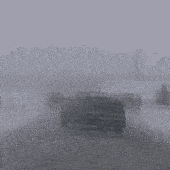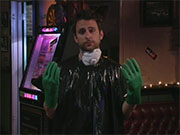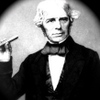- Nckdictator
- Sep 8, 2006
-
Just..someone
|
That was an excellent article. I hadn't heard of the Faro before now
Yeah, it's pretty sobering that for all our modern technology there's still somethings that just can't be solved.
Back in 2012 the Bounty also sank with 2 dead after the captain made a "reckless decision" to sail into Hurricane Sandy. It's a testament to the the Coast Guard that only two died, it easily could've been worse.
https://read.atavist.com/the-sinking-of-the-bounty
quote:Five hundred feet over the Atlantic Ocean, Coast Guard Petty Officer Second Class Randy Haba jammed himself into the rear bucket seat of the Jayhawk helicopter and waited for the doomed ship to come into view. Through the window he could see the crests of the waves and a flotilla of detritus that seemed to spread out in every direction toward the horizon—wormy coils of rope, sharp splinters of yard, tatters of sailcloth. The phosphor screens of his ANVIS-9 night-vision goggles rendered the ocean neon green—a flat, unceasing green that bled into the gray-green of the clouds and the yellow-green of the sky. The kind of green that made it difficult to distinguish distance or depth of field, let alone the blink of the chest-mounted strobe that the guys up in the C-130 transport airplane had sworn was out there, somewhere in the hurricane-roiled sea.
Haba felt the helicopter lurch into a hover. The winds were blowing at close to 90 miles an hour, and in the cabin, Lieutenant Commander Steve Cerveny was fighting the sticks. “Left side,” Lieutenant Jane Peña, the safety pilot, called over the radio. “Got it?”
“Roger,” Haba, the crew’s rescue swimmer, replied. Setting down the ANVIS-9s, he pulled on his fins, dive helmet, mask and snorkel, and thick neoprene gloves. He checked the neck seal of the flame-retardant dive suit and the pockets above the harness, which contained flares, a radio beacon, and one very sharp, spring-loaded knife.
Haba, a six-foot-three former high school football star with hard blue eyes and a weather-beaten face, had been based at the air station in Elizabeth City, North Carolina for more than eight years, the majority of his Coast Guard career. He’d participated in plenty of rescues in the waters off Cape Hatteras, a dangerous patch of sea known by generations of mariners as the “Graveyard of the Atlantic.” There, past the pastel beach houses and salt-stained crab shacks, the North Atlantic’s cold Labrador current collides with the warm waters of the Gulf Stream, yielding frequent storms and high waves capable of swallowing a ship whole.
But Haba had never encountered a situation like this. An hour and a half earlier, he’d been snoozing on a lumpy leather couch at the air station when the call came in: A large wooden ship was in trouble 100 miles east of Elizabeth City with 16 people on board. The ship’s water-removal systems were malfunctioning, and it was limping into the path of Hurricane Sandy, the vast superstorm swirling over the North Carolina coast. Haba had trotted downstairs and rendezvoused with his helicopter crew. One of the command center staffers had printed out a picture of the ship in question from Google Images, and only when he saw it did Haba grasp how strange his morning was about to become. Because the distressed vessel wasn’t a yacht. It wasn’t a schooner. It looked more like a pirate ship.
Bounty, as she was known, was a working replica of the 18th-century tall ship of the same name, commissioned half a century earlier for a film. She measured 120 feet from stern to bow, and 128 feet from keel to masthead. Her three wooden masts held 10,000 square feet of sail. A couple of days earlier, she’d departed New London, Connecticut under the command of Robin Walbridge, a veteran tall-ship captain. At first she’d tacked east, in an effort to avoid the worst of the storm, but at some point, Walbridge had turned the ship southwest, toward shore and Sandy’s perilous center mass. Until 4 a.m., when the crew abandoned ship, she’d been in contact with a C-130, which was still circling overhead at 1,000 feet. After that, there was only silence on the radio.
The number of survivors was uncertain. But the C-130 crew had spotted at least one figure bobbing alone amid the debris—a small shape swaddled in an immersion suit, with a blinking strobe on his chest. The straggler, they called him. Maybe he was dead—a floater—but maybe he wasn’t. Either way, Haba was about to find out. He clipped into the winch, gave a thumbs-up to the flight mechanic, and, the cable whistling behind him, dropped into the waves.
Almost immediately, he began to eat seawater. He was swimming against the current, against the wind. It didn’t help that Cerveny had the Jayhawk so low. The rotor wash was spectacular, drowning out any other sound. Still, Haba paddled like hell, and a minute later, he reached the straggler. The hood of the immersion suit was pulled tight around the guy’s head and all Haba could see was his face, which was covered in fresh lacerations. His skin was pale and his cheeks sunken. One arm hung limply at his side.
With some effort, Haba angled the sling under the man’s other armpit, and pulled the man close to his chest. Sometimes survivors fight back, out of confusion or panic—the surest way to drown is to fight us, rescue swimmers like to say. But the straggler was docile, barely even able to talk, and Haba made good time back to the winch. He gave the thumbs-up to the mechanic and waited for the cable to pull them skyward. Beneath the Jayhawk, illuminated by the rising sun, the tall ship Bounty was slipping under the surface of the sea.
THURSDAY, OCTOBER 25
11:00 A.M.
It amused the hands on the Bounty—a motley collection of retirees, bearded and tattooed twentysomethings, and midlife reinventionists—to watch the Navy guys go all weak-kneed at the sight of the 112-foot masts.
Bounty sailors knew every inch of that rigging, from sheets to spar. But to the local nuclear submarine crew in New London, who had come aboard that afternoon for a demonstration in square-rig sailing, it was utterly unfamiliar territory. In the end, only a few of them were brave enough to strap up and attempt a climb. The weather was calm and overcast, a pleasant 58 degrees.
Later that day, after the sub crew departed, Captain Robin Walbridge convened a brief all-hands meeting. Walbridge was a naturally reserved man, but at musters he presented a calmly confident mien. Peering out over the top of his eyeglasses, a ball cap partially obscuring his brow, he outlined the course for the two weeks ahead. Bounty would depart New London that night—setting sail on a Friday was considered to be bad luck—and head south. If they kept up a pace of 100 miles a day, they could easily make Florida by the second week of November.
That would allow them to meet an obligation in St. Petersburg, a tour for members of an organization that promoted awareness of Down syndrome—and maybe even make a pit stop in Key West, where the crew could swim, hit the bars, and recharge after what was sure to be a difficult voyage south. In mid-November, the Bounty would sail around the tip of Florida, across the Gulf of Mexico, and into Galveston, Texas, where she’d be put up for the winter.
Walbridge was 63, with unruly silver hair and meaty, callused hands. He had come relatively late to professional seafaring, after a series of stints on oil rigs and a short career as a long-haul trucker. He’d grown up in St. Johnsbury, a cloistered town in northeastern Vermont, and claimed to have first sailed at the age of 18, although he was tight-lipped about that part of his life; when his crew members asked his age, he would offer an array of different numbers. Perhaps something painful lurked in his past, they thought. Or perhaps Walbridge simply preferred to talk about his ships.
He’d worked on plenty over the previous two decades, all of them throwbacks in one way or another. There was the 19th-century schooner Governor Stone; the HMS Rose, a tall ship built in 1970 to the specifications of 18th-century British Admiralty drawings; and the USS Constitution, the famous frigate christened by George Washington, on which Walbridge had served as a guest captain once in the 1990s. But his true love was Bounty, a vessel he’d captained since 1995.
Tall-ship crews are usually drawn from two cohorts of people. First there are the amateur adventurers—the retirees and armchair admirals, the recent college graduates putting off adulthood. These volunteers might sail with a tall ship for a week, or a few months, or a year, but they are not paid; in many cases, they are actually billed for berth and board. The second cohort, the mates, tend to be experienced sailors who have decided to make a career out of tall-ship sailing. Generally speaking, they have worked their way up the totem pole, from volunteer to paid hand.
On average, the crew of Bounty numbered around 18, with a small cadre of paid officers, a paid cook, a few lower-ranking hands, and the occasional volunteer. Walbridge never discriminated among the various groups. If anything, he seemed to lavish more attention on the sailors who were still learning to navigate the ship, to take in line and climb the rigging. He was intoxicated by the old-fashioned way of doing things, and he was pleased to be around those who were in the process of becoming intoxicated themselves. “He considered square-rigged sailing a truly dying art, and he was the one keeping the idea alive,” one longtime Bounty hand has said.
And yet Walbridge was no fusty antiquarian. He had sailed the Bounty up and down the East Coast, through the Panama Canal and over to the West Coast, and twice across the Atlantic. Along the way, he’d seen plenty of bad weather, including a pair of hurricanes and pants-shittingly high waves that heaved across the decks, and he had acquired a certain bravado about it. Walbridge was “clearly brilliant,” says a former first mate of Bounty, speaking on the condition of anonymity. “The kind of guy who could play three games of chess at once, who could take apart a diesel engine and put it back together with his bare hands. But the term ‘prudent mariner’ doesn’t really enter the mix.”
The former first mate recalled a series of harrowing close calls aboard the ship, including a “36-hour nightmare ordeal” off Cape Hatteras in 1998, when rough seas sent water pouring into the Bounty’s engine room. Both the Coast Guard and the Navy had sent vessels to the scene, and extra pumps were dropped on board to clear out the water. But in the end, Walbridge declined to be towed back to shore by the Coast Guard—fearing, the first mate believes, that it would prompt a federal investigation. Instead, Bounty managed to sail under her own power back to Charleston for repairs. In a few days, she was at sea again.
Around the same time that Walbridge was convening his crew on Bounty’s deck in New London, on October 25, a new storm, Hurricane Sandy, was arriving on the Florida coast, 1,000 miles to the south. Several crew members who were in the meeting on deck say that Walbridge believed Sandy would barrel up the coast and eventually track inland, somewhere near North Carolina. By sailing southeast before turning south, Bounty could stay windward of the storm. Remaining in Connecticut, Walbridge felt, wasn’t an option—he subscribed to the old maxim that a ship was always safer at sea than at anchor. In a crowded port like New London, there would be practically zero “sea room,” and Bounty would be hemmed in, dangerously close to the docks. Better to take our chances “out there,” Walbridge told the crew.
It was an unusual decision—few other captains in the region, and no other tall-ship captains, were taking any such gamble. And Walbridge, likely mindful of his less experienced hands, was careful to stress that no one was obligated to stay on the Bounty. “I know that quite a few of you all are getting phone calls and emails regarding the hurricane,” Chris Barksdale, the 56-year-old engineer, recalls Walbridge saying. “I wouldn’t blame anyone if you want to get off and I won’t think any worse of you and I won’t hold it against you.”
Josh Scornavacchi crossed his arms and nodded. Scornavacchi, 25, was short and stoutly built, with an earring in his left ear and a mop of unruly reddish hair, which he wore swept across his forehead and cowlicked up in the back. He’d grown up in landlocked Mohnton, Pennsylvania and studied biology at Penn State before signing on as a whitewater-kayaking guide in the Lehigh Gorge. It was there that he’d caught the adventure bug, and hatched a series of increasingly grandiose plans—someday he would hike Everest, float down the Amazon, travel to Congo and Papua, New Guinea. He would buy a boat and sail around the world. But in order to do that, he’d first need to learn how to sail, so in 2011 he’d signed on for a Hudson River tour aboard Clearwater, a sloop owned by the folk singer Pete Seeger.
After the tour, Scornavacchi returned to Mohnton, where he worked shifts at the local Red Robin and looked for another opportunity to ship out. The world of tall ships is tight-knit, and through a friend on Clearwater, Scornavacchi heard of an opportunity on Bounty. He interviewed with John Svendsen, the ship’s 41-year-old first mate, and in the spring of 2012, he flew to Puerto Rico to start a stint as a paid deckhand. The money wasn’t much, but Scornavacchi was deeply enamored with the ship. He loved scrambling up the high-masts, loved the sight of the big canvas under sail, loved the rhythm of life on board—the nights in his gently rocking bunk and the days exploring strange new cities.
With Bounty, Scornavacchi had sailed from Puerto Rico to Florida, up the East Coast to Nova Scotia and back down to Maine, stopping in dozens of ports along the way. Now he would have the chance to experience his first real hurricane. It was a prospect that had not particularly delighted his mother. Earlier that day, he had spoken to her on the phone, and listened to the way the worry made her voice heavy and syrupy. “Mom, I’m not going to die,” he told her. “I promise.” Walbridge was a veteran sailor, he assured her, a man who had crossed the Atlantic multiple times and maneuvered Bounty through some of the most dangerous passages on earth. And Walbridge was backed up by a pair of extremely able lieutenants: Svendsen, the long-haired and taciturn first mate, and second mate Matthew Sanders, an affable 37-year-old with a degree from Maine Maritime Academy. Together, Walbridge, Svendsen, and Sanders had decades of storm experience. “We trusted them,” Scornavacchi recalled later. “We all did. We trusted them completely. And we trusted the boat.”
In the end, none of the crew members took Walbridge up on his offer to get off in Connecticut. Around 8 p.m. that evening, Bounty glided out of the New London harbor, past the navigational buoys and the shuddering glow of the nearby boats, her dual John Deere engines rumbling underfoot, Long Island Sound opening up before her.
FRIDAY, OCTOBER 26
8:00 A.M.
All storms start in miniature, sucking in moisture and matter as they grow, and in this respect, at least, Hurricane Sandy was no different. She had been spotted in the radar images for the first time on October 19, in the Caribbean Sea, that blue breeding ground for hurricanes, an unspectacular whorl of cloud perched southwest of Puerto Rico. Meteorologists dubbed her Tropical Depression 18. She worked her way west, along the coasts of Venezuela and Colombia, before turning north toward Jamaica. Her status was upgraded with alarming regularity, from a tropical depression to a tropical low—a cyclone with a low-pressure core—to a tropical storm. By 11 a.m. EST on October 24, she was a full-fledged hurricane.
Outside the Jamaican capital of Kingston, a city that had not seen a hurricane in 24 years, a man was struck and killed by falling rocks. In Haiti, floods coursed across the lowlands and swept through the post-earthquake tent cities of Port-au-Prince, claiming 54 lives and the homes of 20,000 people. In Cuba, 11 perished and 200,000 homes were damaged or destroyed. In the Dominican Republic, the streets of the capital city of Santo Domingo were submerged and 30,000 people evacuated.
Still accumulating size and strength, Sandy rumbled northward. By October 25, she was just southeast of Florida. News reports indicated that she could eventually reach the magnitude of Katrina and impact the entire Eastern Seaboard from the Southeast to New England. “Now is the time to update your family communication plans, check your supplies, and stay informed,” a high-ranking Federal Emergency Management Agency official warned. “A hurricane isn’t a point on a map—it’s a big storm and its impact will be felt far from the center.” The National Oceanic and Atmospheric Administration predicted gale force winds of up to 70 miles an hour in some areas and widespread storm surges—the rising of the Atlantic Ocean itself. The National Hurricane Center called for a “long-lasting event,” with “two to three days of impact” after the storm had hit.
But the morning of October 26, standing on the stern deck and gazing out in the direction of the Maryland shore, Doug Faunt found it hard to believe there was a storm out there at all. The day was calm and comparatively mild, and above the Bounty’s towering masts, the gulls were circling. Robin is right, Faunt thought. Get clear of the hurricane to the east, and then tack south. Nothing to it. They’d be in Key West in no time, drinking Coronas on the beach. They’d be laughing.
At 66, Faunt was the oldest person on Bounty, and the only volunteer. For most of his life, he’d been a computer engineer in Silicon Valley, a job that had made him plenty of money—not enough to be filthy rich, but enough that he was able to fully retire, without worry, shortly after his 48th birthday. He’d always been an avid reader, and among his favorite books were nautical adventures, like Patrick O’Brian’s Master and Commander novels. And so in the late 1990s, married but without kids, Faunt had set about finally fulfilling his sailing dreams. He’d taken a tour on the Rose, the tall ship re-christened Surprise for the 2003 Master and Commander movie starring Russell Crowe—the same vessel that Robin Walbridge had once helped helm—and sailed across the Atlantic on a century-old steel-hulled barque called the Europa. In his spare time, he rode motorcycles in the war-torn Balkans and backpacked through the western Sahara.
In 2008, as his marriage was disintegrating, Faunt had learned of a vacancy on Bounty, a ship whose history he had studied extensively. The original vessel, he knew, had been built in 1784, in the city of Hull, and christened Bethia, only to be purchased by the British Royal Navy and renamed HMS Bounty three years later. In December of 1787, Bounty had sailed from the port of Spithead, in Hampshire, England, under the command of William Bligh, a 33-year-old lieutenant who had once served with Captain James Cook. Bligh was bound for Tahiti, where the Bounty would pick up a hold’s worth of breadfruit trees and transport them to the West Indies. Sir Joseph Banks, a prominent naturalist with the ear of the king, hoped breadfruit, a meaty and filling food, could eventually become a staple in England; others saw it merely as a cheap source of sustenance for slaves in the colonies.
But Bounty was cursed almost from the outset. She ran into extremely rough weather near the southern tip of Chile, and after 30 days of unsuccessful attempts to round Cape Horn, Bligh was forced to head east, for the Cape of Good Hope and the Indian Ocean. Over the ten months it took to reach Tahiti, a deep and abiding tension developed between Bligh and his crew, especially the master’s mate, Fletcher Christian.
In early April, after half a year in Tahiti, Bligh announced that the procurement of the breadfruit trees was complete—Bounty would set sail for Jamaica, unload her cargo, and return to England. The members of the crew boarded the ship as ordered, but unhappily; many of them had started relationships with Tahitian women, and none of them much enjoyed the prospect of a return voyage as arduous as the first. A few days later, on April 28, 1789, 18 crewmembers under Christian’s direction led Bligh out of his chamber at gunpoint and deposited him in a 23-foot launch along with 22 loyal sailors.
In an exceptional display of seamanship, Bligh managed somehow to pilot the boat 3,618 nautical miles to the Dutch-held port in Timor and went on to enjoy a long if unspectacular career in the Royal Navy. The mutineers, meanwhile, sailed to Pitcairn Island via Tahiti—where they deposited a few of their number—and, after burning and sinking the Bounty there, established a small, self-sufficient colony. The mutineers who remained in Tahiti were eventually apprehended and sent in chains to England to stand trial. The Pitcairn crew, however, succeeded in staying out of view of the admiralty. Their outpost was only discovered in 1808, at which point almost all the mutineers were dead or gone, including Christian.
Beginning with Bligh’s publication of his own account in 1790, the Bounty mutiny became an enduring subject of public fascination, the facts of the incident increasingly obscured beneath layers of speculation and literary invention. Charles Nordhoff and James Norman Hall’s popular 1932 novel Mutiny on the Bounty—in which Bligh is cast as a sadistic disciplinarian and Christian a brave upstart—was adapted four times for the screen and once for the stage, with Christian portrayed by half a century’s worth of leading men: Errol Flynn, Clark Gable, Marlon Brando, and Mel Gibson.
It was for Brando’s outing that MGM Studios had asked the Smith & Rhuland shipyard in Lunenburg, Nova Scotia, to build a replica—the most exacting and accurate that had ever been created for a film. The shipbuilders consulted the Bounty’s drawings in the archives of the British Admiralty. Their only significant amendments to the original were the ship’s size—the 18th-century ship was 90 feet from stem to stern, close quarters for a film crew—and a pair of diesel engines. Once filming concluded, Brando insisted that the ship be preserved and not burned for the final scene, as the producers had originally intended. So Bounty was sent to St. Petersburg, Florida, where she remained for more than 20 years.
In 1986, Ted Turner, the founder of CNN, acquired MGM’s entire library of film props, including Bounty. In the years that followed, the ship appeared in a handful of other movies—among them a 1990 Treasure Island adaptation starring Charlton Heston and, later, two of the Pirates of the Caribbean films—but Turner had no great desire to hang on to the ship. In 1993, he donated her to the Fall River Chamber Foundation, in Massachusetts, which in turn established the Tall Ship Bounty Foundation. Robin Walbridge was brought on a year later.
Under Walbridge’s direction, Bounty joined the community of tall ships that crisscross the globe in the summer months. It was a sort of inverse tourism circuit: The ships would lay up for a few days in one harbor, long enough for locals and visitors to admire the high masts and ballooning sails, then push off for another port of call. Maintenance, supplies, and crew salaries were financed with ticket sales, the ten bucks they charged people to climb aboard, wander belowdecks or pose for pictures beside the replica cannons.
Before joining the replica Bounty as a volunteer, in 2008, Doug Faunt made it his business to read every book he could on the original ship. He kept pictures of Bounty around his house in Oakland, and tacked additional images above his berth. The vessel bewitched him; he believed Walbridge when the captain told him that Bounty was “the most famous ship afloat in the entire world.”
And yet Faunt was not unaware of the subpar condition in which the Bounty found herself at middle age. In 2001, Robert Hansen, the millionaire founder of Islandaire, an air-conditioning company, had purchased Bounty from the Tall Ship Bounty Foundation. He had kept Walbridge as captain, and also provided a much-needed infusion of funds to help maintain the vessel and pay the sailors. But even with his respectable fortune, he seemed unable to keep up with the intensive and regular maintenance a ship of Bounty’s size required. There were always repairs to be done, and never enough money to do them.
Before arriving in New London, Bounty had spent several weeks in dry dock in Boothbay Harbor, Maine, where workers and crew members replaced some rotted planking and installed a pair of new fuel tanks. In Connecticut, two new stoves had been driven down by Tracy Simonin, an employee of the HMS Bounty Foundation, and installed by Faunt and Barksdale. Very much a work in progress, was how Faunt referred to the ship. Still, like practically all the hands on board, Faunt, one of Bounty’s volunteer engineers, believed the ship would get them to Galveston, where he had planned to undertake an array of improvements.
Now Faunt leaned against the railing on the stern deck, listening to the reassuring gurgle of the John Deeres. They were at full power, motoring fast southeast, and the entire ship shook with their effort. At the bow, his fellow sailors were double-checking the lines, shimmying up the mainmast. The wind was blowing, but not violently, and he could feel the sun on his neck.
SATURDAY, OCTOBER 27
11:00 A.M.
The Saffir–Simpson hurricane scale separates storms into five categories. A Category 1 hurricane, the weakest on the spectrum, is defined as having sustained winds of 74 miles per hour; in a Category 5 storm, winds regularly reach 157 miles per hour—enough to rip the roof off a house. On Saturday, October 27, two days after Bounty left New London, Sandy was a mild Cat 1, flirting with tropical storm designation. And yet her low intensity belied her remarkable size. NASA satellite images taken at the time show a swirling gauze knot, with a compact core and tendrils that extended across a 1,000 mile swath of the Atlantic Ocean, from Florida to the Chesapeake Bay.
According to Laura Groves, Bounty’s 28-year-old boatswain—an officer in charge of equipment maintenance—beginning on Friday, the crew had printed out maps from the ship’s weatherfax. They posted them in the hallway belowdecks so all hands would have a chance to track the storm’s progress and the location of Bounty relative to it. Those maps would have shown Bounty approximately 200 miles from the Virginia shore, on the eastern edge of the storm. So far, so good—if the storm kept up its current pace and trajectory, the ship could still skirt the worst of the winds and bypass Sandy once she turned inland.
And yet it seemed increasingly probable that Sandy would soon clash with a fast-moving cold front, which had swept down from Canada and across the Midwest. As NOAA forecasters pointed out, the two systems, both dangerous in their own right, threatened to merge into one colossal “Frankenstorm.” The prospect was terrifying. The last major hybrid storm to hit the East Coast was the Halloween Nor’easter of 1991—the “perfect storm” immortalized by Sebastian Junger—which occurred when a low-pressure system from Canada swallowed the Category 2 Hurricane Grace and slammed into the coast of Massachusetts, killing 13 people.
On the Bounty, sea-stowing preparations began in earnest. Anything loose, from heavy appliances to the crew’s baggage, had to be lashed down. The crew furled most of the sails to reduce weight aloft, leaving only the forecourse, the lowest sail on the foremast. This was the Bounty’s storm sail—it would be needed to help steady the ship in a gale.
Doug Faunt spent most of the morning belowdecks. An inveterate radio geek, a couple of years earlier he’d installed a Winlink system that could be used to transmit email messages via shortwave radio signals in the event of an emergency. Faunt double-checked the wires and booted up the system—all was in working order. Next he made his way aft, where the washer and dryer, previously secured, had moved six inches. They had to be tied down again, this time with extra line.
Faunt was joined for part of his shift by Claudene Christian, one of the newest members of the Bounty crew. Christian was 42, a bleach-blond former beauty queen who seemed to have lived enough lives for 10 women. She had grown up in Alaska, where she’d competed in pageants from an early age. At the University of Southern California, in Los Angeles, she’d been a cheerleader—experience she parlayed into a career when she founded the company Cheerleader Doll. In 1997, the Barbie manufacturer Mattel sued Christian and her father, Rex Christian, for patent infringement, and Claudene was forced to abandon the company. According to Los Angeles magazine, Christian subsequently sued her own lawyer for “gross misconduct,” and settled out of court for $1 million.
Suddenly flush with cash, Christian bounced around the West Coast. She sang with a band named the Mad Tea Party, did PR for a racetrack in Hermosa Beach, and became a partner in Dragons, a trackside bar. She drank heavily, dated the wrong men, and acted erratically—at one point, she reportedly purchased an expensive, life-size statue of a policeman for her front porch. In 2007, she was diagnosed with a bipolar disorder and hospitalized. Her bank account nearly depleted, she moved back home. Several years later, she discovered the sea.
She shipped out for the first time in 2011, as a cook on the Niña, a 65-foot replica of Columbus’s ship. She spent three months on board, lived for a time in rural Oklahoma—where her family had moved—and in May 2012, trucked out to Wilmington, North Carolina, to join the crew of Bounty. When she was growing up, Rex Christian had always told his daughter she was a descendant of Fletcher Christian, the leader of the 1789 mutiny. This may or may not have been true, but Claudene certainly believed it; it was one of the first things she told the other Bounty hands.
Christian was immensely popular on board Bounty. She was charming, warm, and unflaggingly ebullient—a “sparkplug,” Faunt called her. But Faunt knew inner darkness when he saw it. His father had been an alcoholic, and his mother, who had struggled with mental illness, had committed suicide with a shotgun shortly after Faunt graduated from high school. He told Christian stories of his childhood, in South Carolina, and listened while Christian spilled the details of her own past.
For Christian, Bounty was a chance to start over—to make up for what she described as her “failures” in California. She threw herself into her daily duties with alacrity, taking on tasks others tried to shirk. In the evenings, sweaty and soused with salt water, she’d often join Josh Scornavacchi on deck for an impromptu jam session. Scornavacchi had brought a pair of bongos, and Christian sang along to old rock songs, her voice bright and unwavering.
Shortly before Bounty departed from Boothbay Harbor, Christian was promoted by Walbridge from volunteer to paid hand—a position for which she’d earn 100 bucks a week. “Volunteer with drinking money,” was how Walbridge phrased it, but Christian was immensely proud of her new position. It gave her status, but more importantly, it validated her feeling that she belonged on the Bounty.
But Christian was still a green sailor, and she had never experienced bad weather at sea. The approaching storm clearly scared her in a way that it did not scare the more seasoned hands. In an email conversation with her friend Rex Halbeisen after leaving Connecticut, she said she was “praying to God that going to sea was the right decision,” and expressed concern with the equipment on Bounty. “You know me, I am not a mechanical person but the generators and engines on this ship are not the most reliable,” she told Halbeisen. “They are always stewing over them. I would hate to be out to sea in a storm and the engines just quit or we have no power.”
But by the time she sent a subsequent text message to her mother, probably late on Saturday night, Christian seemed to have made peace with her misgivings. “Just be sure that I am ok and HAPPY TO BE HERE on Bounty doing what I love,” she wrote. “And if I do go down with the ship & the worst happens… Just know that I AM GENUINELY HAPPY!! And I am doing what I love! I love you.”
Five
SATURDAY, OCTOBER 27
1:00 P.M.
By Saturday afternoon, Bounty was a couple of hundred miles due east of the border of North Carolina and Virginia, and Robin Walbridge made the decision to change course. He would now steer the ship southwest, toward the coast.
It was a tactic he had used before when sailing in the vicinity of large storms. “You try to get up as close to the eye as you can, and you stay down in the southeast quadrant and when it stops you stop, you don’t want to get in front of it,” he said in a 2012 television interview. “You’ll get a good ride out of the hurricane.” As third mate Dan Cleveland later recalled, Walbridge reasoned that by October 27, Bounty had made it out far enough beyond Sandy’s eye that if he steered inland again, the winds whipping counterclockwise out along the margins of the storm would help propel the ship to St. Petersburg.
Walbridge reminded his senior officers that he had a good sense of how storms behaved. “He [was] never a yeller or a screamer,” Cleveland later testified. “When things would go wrong, you’d never see him freak out, he’d handle situations in a calm manner. I never saw him get nervous or scared. It made you feel like you could handle things.”
Cleveland, a 25-year-old former landscaper who other crew members say “worshipped” Walbridge, had been through a few bad storms on Bounty, too, including one in 2008 that hit the ship as she made her way north to Louisiana from the mouth of the Panama Canal. He had heard the saying, popular among crew members, that “Bounty loves a hurricane,” and although he was loath to go that far himself, he did believe that the ship handled well in strong winds. “She works hard and you work hard,” was the way he put it. In the end, neither Cleveland nor the other senior officers who might have had a say in navigational matters ever objected to the new southwestern tack.
But Walbridge had made a miscalculation. His plan assumed both that the forecasts of Sandy’s path would hold, and that it was possible to get around Sandy at all—that she was a hurricane of normal size, a few hundred miles across. Irene, in 2011, had been 600 miles in diameter; Katrina, in 2005, measured only 415 miles from edge to edge. Skirtable distances, if your ship was well-equipped and moving fast. But Sandy was not skirtable. Meteorologists later estimated that she was the largest hurricane ever recorded in the Atlantic Basin, with a diameter of 1,000 miles, and a wind swath of 2 million square miles. If Walbridge had kept to his original southeasterly course, it was conceivable that he might have made it to Sandy’s edge. Instead, now he was unwittingly sailing Bounty directly into her maw.
That afternoon, the weather worsened. Winds were now reaching over 30 miles per hour, waves were climbing to 15 and 20 feet. A cold rain fell periodically overhead. Bounty rocked irregularly, making it hard to get any rest belowdecks. Even simple actions, like moving around the cabin or walking down the passageway to the head, required concentration and energy.
More distressingly, it had become clear that Bounty was taking on a considerable amount of water. It seeped through the ceiling and across the floorboards and through the forepeak. It spouted through the walls and squirted down from the ceiling and collected in greasy little pools in the corners of the cabins. The floors turned slippery, the stairs and ladders downright murderous. All wooden ships leak, of course, and some of the crew members comforted themselves with the fact that Bounty had pumped herself out of a few disasters before. There were five pumps on board—two electric, two hydraulic, and one “trash pump,” a smaller unit that could be hauled around to different locations on the ship. But the hydraulic and electric pumps were working at peak capacity, and still the water was rising.
At 8 a.m. on Sunday morning, after a long and mostly sleepless night, Walbridge gathered his mates in the navigation shack for a meeting. Chris Barksdale, the engineer, was also invited. Barksdale, a handyman by trade, was already seasick—later that day, when a crewmate gave him a pill for it, he vomited it back up. Walbridge pinpointed Bounty’s location on a map, and reviewed the plan for the day ahead: southwest and then south and straight on toward St. Petersburg.
At this point, Laura Groves later recalled, the seas were 25 feet and the wind was blowing at nearly 60 miles per hour. After the meeting concluded, around 8:45 a.m., she departed to help adjust the jack lines, the bow-to-stern lines that allow sailors to move safely around the deck of a storm-struck ship. Groves believed that the end was in sight, especially once they’d swung over the bottom quadrant of the hurricane and put the storm behind them. There was not yet much cause for concern, she thought.
This was not an opinion shared by Doug Faunt, who had spent Saturday night and much of Sunday morning in the engine room, monitoring the pumps. If the devices were unable to keep up with the seawater, the engine room would flood. And if the engine room flooded, Bounty would eventually find herself entirely at the mercy of the growing storm, batted about by the waves like a toy boat. The replica Bounty would be forced to rely solely on her sails, just as her namesake once had.
Faunt dashed from one engine to the next, minding the meters, tinkering with the levers, cursing under his breath. It must have been 120 degrees in that room, and humid as hell. He stripped down to his T-shirt and underwear and hiking boots, occasionally ducking through the hatch for a breath of fresh air. It was exhausting work, and at noon, he handed off the baton to another crewmember and crawled back upstairs to try to catch a few hours of sleep. When he got to his cabin, he found the room flooded and his gear soaked. He climbed naked into his sleeping bag. The bag was polyester, not cotton, and although the sensation was uncomfortable—not unlike folding your body into a used athletic sock—it did afford a bit of warmth.
Faunt had barely closed his eyes when he heard someone shout the “all hands on deck” call. You’ve got to be kidding me, he thought. He shouted his acknowledgment, fumbled for his sweat- and seawater-soaked clothing, and dressed in the damp darkness.
Six
SUNDAY, OCTOBER 28
12:30 P.M.
Josh Scornavacchi made it on deck a few minutes before Doug Faunt. Looking up at the masts, he saw the reason for the all-hands call: the forecourse was split, and the canvas was flying free. The forecourse was the Bounty’s storm sail; it helped steady her. It had to be furled. So Scornavacchi began to climb. He was a strong climber, comfortable with heights, but the rigging seemed to just get smaller and wetter as he shimmied upwards. The wind whipped the ropes around him into a fury, lashing him on the arms and neck hard enough to draw welts. Nevertheless, within the next hour, Scornavacchi, Laura Groves, and John Svendsen were able to secure the sail to the gaskets on the top of the yard.
While Scornavacchi was aloft, Faunt and Claudene Christian were taking up or paying out the lines as needed. The task had fallen to them partially because they were late in arriving on deck, and mostly because Faunt was fatigued and Christian couldn’t be trusted aloft. Despite having been on the Bounty for several months, Christian was still very much a novice when it came to the workings of the ship. Faunt, who often shared shifts with her, regarded her as something of a slow learner. “It wasn’t that she wasn’t brave,” he would later recall. “She was. She was brave and she had a lot of heart and she had passion for the Bounty. But you usually had to repeat things several times before she really got it.”
Now she fixed Faunt with an intent stare, and complained that no one on the ship was listening to her. “What aren’t they listening to?” Faunt asked. He had to holler over the roar of the storm. Behind them, 30-foot waves were breaking over the foredeck.
“We’re taking on too much water. The pumping isn’t going well. We’ve got big problems.”
“I know,” he said. “We all know.” There wasn’t a person aboard the Bounty who didn’t know the ship was in trouble. But it did no good to complain about it. It was better to keep your head down and do what you could to make sure everyone got out of this mess alive. Faunt tried to reassure Christian. “Listen,” he said. “It’s going to be fine.”
That evening, Sandy closed in on Cape Hatteras. The storm had now merged as predicted with the easterly moving cold front. Meteorologists were reporting a noticeable drop in the atmospheric pressure off the coast of North Carolina, a sign that the storm was entering an even more dangerous phase. Bounty, a couple of hundred miles southeast of the cape, had found herself square in the middle of the storm system, with little hope of sailing her way back out.
As night fell over Bounty, visibility that had been limited enough at twilight, when a veil of rain enclosed the ship, was whittled down to practically nothing. The swells rose like battlements around her. Scornavacchi ducked through the aft hatch to check on his cabin. What he saw startled him: several boards had been ripped up from the floor and were swirling around in the wash. He understood the gravity of the situation, but he also felt strangely energized. Back home in Pennsylvania, he had longed for an adventure. Now he had found one.
Around 8 p.m., the winds again tore the forecourse loose, and again Scornavacchi was sent aloft to deal with it. He scaled the foremast with extreme caution. A hard hail pelted him in the face; he could barely see, let alone hear anything. A couple of dozen feet below him, the bow of the ship shot down the trough of one wave and up the sheer face of the next. Black water coursed across the deck. Occasionally, the ship would list nearly at beam-ends, the deck at an almost perpendicular angle to the sea and the crew clinging to anything they could get their hands on.
The sail furled, Scornavacchi made his way belowdecks. There, the water had risen further still, and the crew was working microshifts to keep it at bay, a couple of minutes lying down followed by a couple of minutes working the pump. Then, suddenly, the world went sideways, then straight again. There was a scream and then a moan. Scornavacchi and his shipmates assessed the situation. Having to abandon ship was now a real possibility. But surely the Bounty would stay afloat, even if she were to permanently topple over on her side. Surely she wasn’t about to sink just yet.
At this point, there were already two injured sailors aboard the Bounty. One was a 27-year-old named Adam Prokosch, who had been tossed headfirst across the mess by a particularly high wave. Christian set up a mattress in a dry part of the ship, and made Prokosch lie on his back, with his hands at his sides. It was clear that he was badly hurt; Christian worried that he might be partially paralyzed. She told him not to move.
Meanwhile, Walbridge had suffered an injury of his own, likely caused when he collided with the table in his cabin. Several sailors on board later recalled that he was moving only with extreme effort, bracing himself with both hands. Scornavacchi believes Walbridge broke his back; Faunt thinks it may have been a leg. Either would have been an ominous development. Unless you’re extremely lucky, escaping a sinking ship without full ambulatory control is all but impossible.
As Bounty’s engineer, it was Chris Barksdale’s job to maintain the generators, the pumps, and the diesel engines that powered the ship. In a subsequent interview with Popular Mechanics, Barksdale recalled that the pumps became clogged early Sunday afternoon; Walbridge himself did the unclogging, but it was to little avail. The water was flooding into Bounty much faster than it was going out. As the ship rolled, the water in the engine room and the bilge would heave up the walls and slosh back down over the equipment. The engines sputtered, churned, and sometime after nightfall, with a dull whine, gave out completely. The Bounty was now adrift.
At 9 p.m. Walbridge and Faunt descended to the radio room to call for help. Bounty was noticeably light on communications systems—most of the time, the crew members relied on their cell phones. Closer to the coast, in calm weather, this wasn’t a problem. But Bounty was now a hundred-odd miles out to sea, and no one on board had any reception. It was too windy abovedecks to conduct a conversation, which meant that the ship’s satellite phone—which got no reception belowdecks—was no good either. So Walbridge and Faunt decided to issue the Mayday call on the Winlink system. You almost had to laugh, Faunt thought—they were going to peck out their drat SOS via email.
Still, the system worked fine, and after confirming that the message had gone through, Faunt left Walbridge and made his way forward toward the galley, bracing himself with both hands. The generators were surging badly, and the lights were flickering on and off like disco strobes. After a while, the backup generator kicked in. In the yellow glare of the emergency lights, Faunt could see the other crew members organizing emergency supplies and tending to Prokosch, who was on his back on the mattress.
The next two hours passed in a delirious blur. Salt water would get into one light fixture, and Faunt would no sooner get it clean and working again than the next one would burst. There were electrical fires to put out, pumping to do in the engine room, and loose wood to secure in the tank room, which was now fully flooded. The Bounty was coming apart before Faunt’s eyes.
He dashed back to his cabin and took a quick inventory. He wouldn’t be able to bring much with him—he was going to lose his bicycle, most of his clothing, his radio gear, his books. In the end, he settled on his rescue knife and his teddy bear, Mush, which he strapped to his chest.
Engineless, the Bounty spun windward up the crest of one three-story wave only to be knocked leeward by the next. At around midnight, the first Coast Guard C-130, piloted by Lieutenant Wes McIntosh, came into range, and the Bounty was able to establish radio contact. There was a small cheer from the navigation shack. McIntosh requested that the crew shine a light on the rigging, and Faunt activated the search beam.
For the next couple of hours, the C-130, heavy with fuel, circled overhead, sometimes at 1,000 feet and sometimes at 500. “Someone tell that guy we’re 110 feet,” Walbridge joked. “He’s going to clip us!” There was still time for levity: according to Faunt, despite the six feet of water in the belly of the ship, Walbridge and Svendsen believed that the Bounty might yet be saved, if only the Coast Guard could find a way to lower some working pumps. But McIntosh could barely see half a mile in the rain, and the winds were blowing at between 80 and 90 miles an hour. A gear drop was impossible. The only thing the crew of the Bounty could do was hold on until morning, when a helicopter could be summoned from Elizabeth City. It seemed to Faunt an awful long time to wait.
(Too long to post in a single post, going to make a second one)
Nckdictator fucked around with this message at 01:44 on Oct 31, 2016
|





 Warning - there is no visibly graphic footage, but his distress is clearly apparent and audibly gruesome. Slate had a pretty good write up of the circumstances http://www.slate.com/blogs/atlas_obscura/2014/03/04/diver_s_cemetery_the_blue_hole_of_dahab_on_the_red_sea_in_egypt.html
Warning - there is no visibly graphic footage, but his distress is clearly apparent and audibly gruesome. Slate had a pretty good write up of the circumstances http://www.slate.com/blogs/atlas_obscura/2014/03/04/diver_s_cemetery_the_blue_hole_of_dahab_on_the_red_sea_in_egypt.html



 I'll do some effort posting of my own when my work lets up a bit.
I'll do some effort posting of my own when my work lets up a bit.















 Bad Angus! Bad!
Bad Angus! Bad!

























